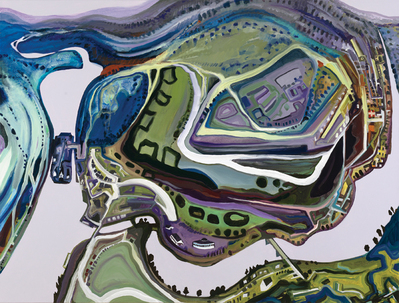Land Ho!
Sandy Litchfield, Hook and Swill, 2015, oil and acrylic on canvas, 38 x 54″. Courtesy of the artist and Carroll and Sons Gallery, Boston, MA.
Fitchburg Art Museum’s (FAM) Land Ho! is an enthusiastic gathering of landscapes by eight contemporary, New England artists alongside those from FAM’s permanent collection, representing American artists like John Twachtman, Charles Burchfield, and Rockwell Kent. Although interpretive materials are available, the impulse is to explore this show on one’s own, wandering from gallery to gallery across the museum’s second floor, and enjoying activities in the family-friendly interactive zone.
Land Ho! mingles tradition with shifting boundaries. Some groupings are displayed in salon-style constellations. The viewer’s eye glances from the undulating aerial abstractions of Amherst, MA, painter Sandy Litchfield to the reassuringly balanced blues, olive greens and clay reds of the traditional landscapes with surprising ease. Sometimes a pairing is so apt that it is hard to imagine anything but complete understanding between the artists, as in the stacking of William Anderson Coffin’s Evening with David Gloman’s Yellow Dawn—seeming bookends to the same day, though in fact separated by nearly a century.
While the juxtaposition of old and new is intriguing, the contemporary art often astounds on its own. Warner Friedman’s trompe-l’oeil paintings and Sally Curcio’s minute beadwork worlds preserved under domes are loaded with cultural points of reference that offer to guide the viewer, but the jousting between reality and imagination in these works coyly subverts this intention.
Several monumental canvases from the ongoing series This Land Is My Land by Newport, RI, painter Sue McNally could have overwhelmed the exhibition easily, but they are kept in check by skillful arrangement. McNally’s Cholla, New Mexico (2015) is flanked by two large, yet delicate, mixed media pieces from Michele Lauriat’s 2015 series Pink Iowa, pinned up to create the wings of an accidental triptych. McNally’s distant horizon—vast enough to convincingly show the curve of the earth—is contained by Lauriat’s vertical trees and confusion of foreground bracken.
Land Ho! is witty, and there is a message behind the mirth. Curator Mary M. Tinti maintains that the title references the sense of recognition mingled with discovery that comes with sighting land after a long period at sea. Land Ho! welcomes, but with a caveat: our jaded mode of seeing must be upended for a renewed appreciation of the landscape.

